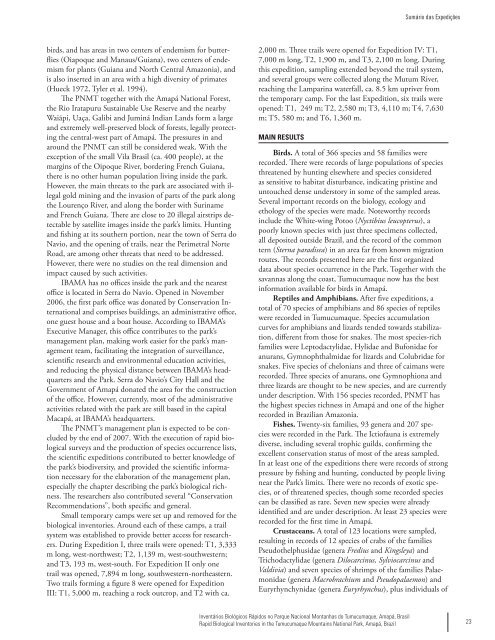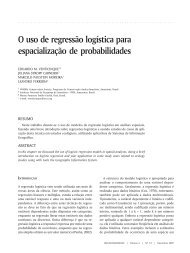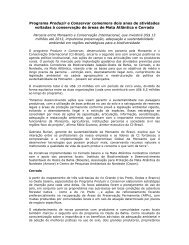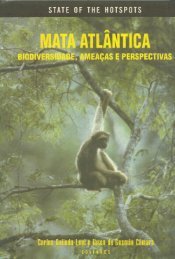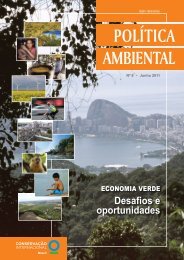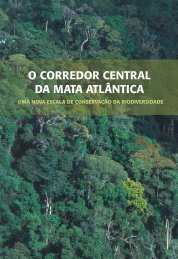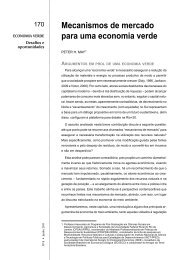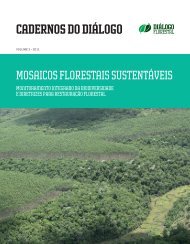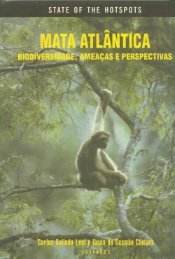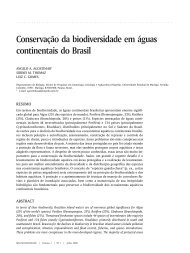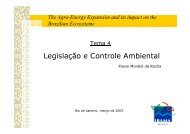Rapid Assessment Program - Conservação Internacional
Rapid Assessment Program - Conservação Internacional
Rapid Assessment Program - Conservação Internacional
Create successful ePaper yourself
Turn your PDF publications into a flip-book with our unique Google optimized e-Paper software.
irds, and has areas in two centers of endemism for butterflies<br />
(Oiapoque and Manaus/Guiana), two centers of endemism<br />
for plants (Guiana and North Central Amazonia), and<br />
is also inserted in an area with a high diversity of primates<br />
(Hueck 1972, Tyler et al. 1994).<br />
The PNMT together with the Amapá National Forest,<br />
the Rio Iratapuru Sustainable Use Reserve and the nearby<br />
Waiãpi, Uaça, Galibi and Juminá Indian Lands form a large<br />
and extremely well-preserved block of forests, legally protecting<br />
the central-west part of Amapá. The pressures in and<br />
around the PNMT can still be considered weak. With the<br />
exception of the small Vila Brasil (ca. 400 people), at the<br />
margins of the Oipoque River, bordering French Guiana,<br />
there is no other human population living inside the park.<br />
However, the main threats to the park are associated with illegal<br />
gold mining and the invasion of parts of the park along<br />
the Lourenço River, and along the border with Suriname<br />
and French Guiana. There are close to 20 illegal airstrips detectable<br />
by satellite images inside the park’s limits. Hunting<br />
and fishing at its southern portion, near the town of Serra do<br />
Navio, and the opening of trails, near the Perimetral Norte<br />
Road, are among other threats that need to be addressed.<br />
However, there were no studies on the real dimension and<br />
impact caused by such activities.<br />
IBAMA has no offices inside the park and the nearest<br />
office is located in Serra do Navio. Opened in November<br />
2006, the first park office was donated by Conservation International<br />
and comprises buildings, an administrative office,<br />
one guest house and a boat house. According to IBAMA’s<br />
Executive Manager, this office contributes to the park’s<br />
management plan, making work easier for the park’s management<br />
team, facilitating the integration of surveillance,<br />
scientific research and environmental education activities,<br />
and reducing the physical distance between IBAMA’s headquarters<br />
and the Park. Serra do Navio’s City Hall and the<br />
Government of Amapá donated the area for the construction<br />
of the office. However, currently, most of the administrative<br />
activities related with the park are still based in the capital<br />
Macapá, at IBAMA’s headquarters.<br />
The PNMT’s management plan is expected to be concluded<br />
by the end of 2007. With the execution of rapid biological<br />
surveys and the production of species occurrence lists,<br />
the scientific expeditions contributed to better knowledge of<br />
the park’s biodiversity, and provided the scientific information<br />
necessary for the elaboration of the management plan,<br />
especially the chapter describing the park’s biological richness.<br />
The researchers also contributed several “Conservation<br />
Recommendations”, both specific and general.<br />
Small temporary camps were set up and removed for the<br />
biological inventories. Around each of these camps, a trail<br />
system was established to provide better access for researchers.<br />
During Expedition I, three trails were opened: T1, 3,333<br />
m long, west-northwest; T2, 1,139 m, west-southwestern;<br />
and T3, 193 m, west-south. For Expedition II only one<br />
trail was opened, 7,894 m long, southwestern-northeastern.<br />
Two trails forming a figure 8 were opened for Expedition<br />
III: T1, 5,000 m, reaching a rock outcrop, and T2 with ca.<br />
Inventários Biológicos Rápidos no Parque Nacional Montanhas do Tumucumaque, Amapá, Brasil<br />
<strong>Rapid</strong> Biological Inventories in the Tumucumaque Mountains National Park, Amapá, Brazil<br />
Sumário das Expedições<br />
2,000 m. Three trails were opened for Expedition IV: T1,<br />
7,000 m long, T2, 1,900 m, and T3, 2,100 m long. During<br />
this expedition, sampling extended beyond the trail system,<br />
and several groups were collected along the Mutum River,<br />
reaching the Lamparina waterfall, ca. 8.5 km upriver from<br />
the temporary camp. For the last Expedition, six trails were<br />
opened: T1, 249 m; T2, 2,580 m; T3, 4,110 m; T4, 7,630<br />
m; T5, 580 m; and T6, 1,360 m.<br />
MAIN RESulTS<br />
Birds. A total of 366 species and 58 families were<br />
recorded. There were records of large populations of species<br />
threatened by hunting elsewhere and species considered<br />
as sensitive to habitat disturbance, indicating pristine and<br />
untouched dense understory in some of the sampled areas.<br />
Several important records on the biology, ecology and<br />
ethology of the species were made. Noteworthy records<br />
include the White-wing Potoo (Nyctibius leucopterus), a<br />
poorly known species with just three specimens collected,<br />
all deposited outside Brazil, and the record of the common<br />
tern (Sterna paradisea) in an area far from known migration<br />
routes. The records presented here are the first organized<br />
data about species occurrence in the Park. Together with the<br />
savannas along the coast, Tumucumaque now has the best<br />
information available for birds in Amapá.<br />
Reptiles and Amphibians. After five expeditions, a<br />
total of 70 species of amphibians and 86 species of reptiles<br />
were recorded in Tumucumaque. Species accumulation<br />
curves for amphibians and lizards tended towards stabilization,<br />
different from those for snakes. The most species-rich<br />
families were Leptodactylidae, Hylidae and Bufonidae for<br />
anurans, Gymnophthalmidae for lizards and Colubridae for<br />
snakes. Five species of chelonians and three of caimans were<br />
recorded. Three species of anurans, one Gymnophiona and<br />
three lizards are thought to be new species, and are currently<br />
under description. With 156 species recorded, PNMT has<br />
the highest species richness in Amapá and one of the higher<br />
recorded in Brazilian Amazonia.<br />
Fishes. Twenty-six families, 93 genera and 207 species<br />
were recorded in the Park. The Ictiofauna is extremely<br />
diverse, including several trophic guilds, confirming the<br />
excellent conservation status of most of the areas sampled.<br />
In at least one of the expeditions there were records of strong<br />
pressure by fishing and hunting, conducted by people living<br />
near the Park’s limits. There were no records of exotic species,<br />
or of threatened species, though some recorded species<br />
can be classified as rare. Seven new species were already<br />
identified and are under description. At least 23 species were<br />
recorded for the first time in Amapá.<br />
Crustaceans. A total of 123 locations were sampled,<br />
resulting in records of 12 species of crabs of the families<br />
Pseudothelphusidae (genera Fredius and Kingsleya) and<br />
Trichodactylidae (genera Dilocarcinus, Sylviocarcinus and<br />
Valdivia) and seven species of shrimps of the families Palaemonidae<br />
(genera Macrobrachium and Pseudopalaemon) and<br />
Euryrhynchynidae (genera Euryrhynchus), plus individuals of<br />
2


